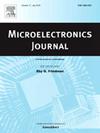Design of a low power LED driver with adjustable LDO
IF 1.9
3区 工程技术
Q3 ENGINEERING, ELECTRICAL & ELECTRONIC
引用次数: 0
Abstract
The issue of high power consumption in the standby state of the driver chip for conventional LED is addressed by proposing an adjustable LDO. This LDO optimizes the static power consumption current of the LED driver chip through a power management circuit. In standby mode, a portion of the LDO circuit and the driver chip display circuit are deactivated, effectively reducing the static power consumption current of the driver chip. The standby mode static power consumption current of the LED driver chip equipped with adjustable LDO is measured to be 46.82μA, while the static power consumption current of the LED driver chip without adjustable LDO amounts to 151.83μA. In standby mode, compared to the non-adjustable option, there is a reduction of 105μA in adjustable power consumption current, with a corresponding static power consumption of only 0.23 mW for the LED driver chip. The LED driver chip designed in this paper is realized using a 180 nm BCD process.
具有可调LDO的低功耗LED驱动器的设计
提出了一种可调LDO,解决了传统LED驱动芯片待机状态下的高功耗问题。该LDO通过电源管理电路优化LED驱动芯片的静态功耗电流。在待机模式下,LDO电路和驱动芯片显示电路的一部分失活,有效降低了驱动芯片的静态功耗电流。配置可调LDO的LED驱动芯片待机静态功耗电流为46.82μA,未配置可调LDO的LED驱动芯片待机静态功耗电流为151.83μA。在待机模式下,与非可调选项相比,LED驱动芯片的可调功耗电流减少了105μA,相应的静态功耗仅为0.23 mW。本文设计的LED驱动芯片采用180nm的BCD工艺实现。
本文章由计算机程序翻译,如有差异,请以英文原文为准。
求助全文
约1分钟内获得全文
求助全文
来源期刊

Microelectronics Journal
工程技术-工程:电子与电气
CiteScore
4.00
自引率
27.30%
发文量
222
审稿时长
43 days
期刊介绍:
Published since 1969, the Microelectronics Journal is an international forum for the dissemination of research and applications of microelectronic systems, circuits, and emerging technologies. Papers published in the Microelectronics Journal have undergone peer review to ensure originality, relevance, and timeliness. The journal thus provides a worldwide, regular, and comprehensive update on microelectronic circuits and systems.
The Microelectronics Journal invites papers describing significant research and applications in all of the areas listed below. Comprehensive review/survey papers covering recent developments will also be considered. The Microelectronics Journal covers circuits and systems. This topic includes but is not limited to: Analog, digital, mixed, and RF circuits and related design methodologies; Logic, architectural, and system level synthesis; Testing, design for testability, built-in self-test; Area, power, and thermal analysis and design; Mixed-domain simulation and design; Embedded systems; Non-von Neumann computing and related technologies and circuits; Design and test of high complexity systems integration; SoC, NoC, SIP, and NIP design and test; 3-D integration design and analysis; Emerging device technologies and circuits, such as FinFETs, SETs, spintronics, SFQ, MTJ, etc.
Application aspects such as signal and image processing including circuits for cryptography, sensors, and actuators including sensor networks, reliability and quality issues, and economic models are also welcome.
 求助内容:
求助内容: 应助结果提醒方式:
应助结果提醒方式:


